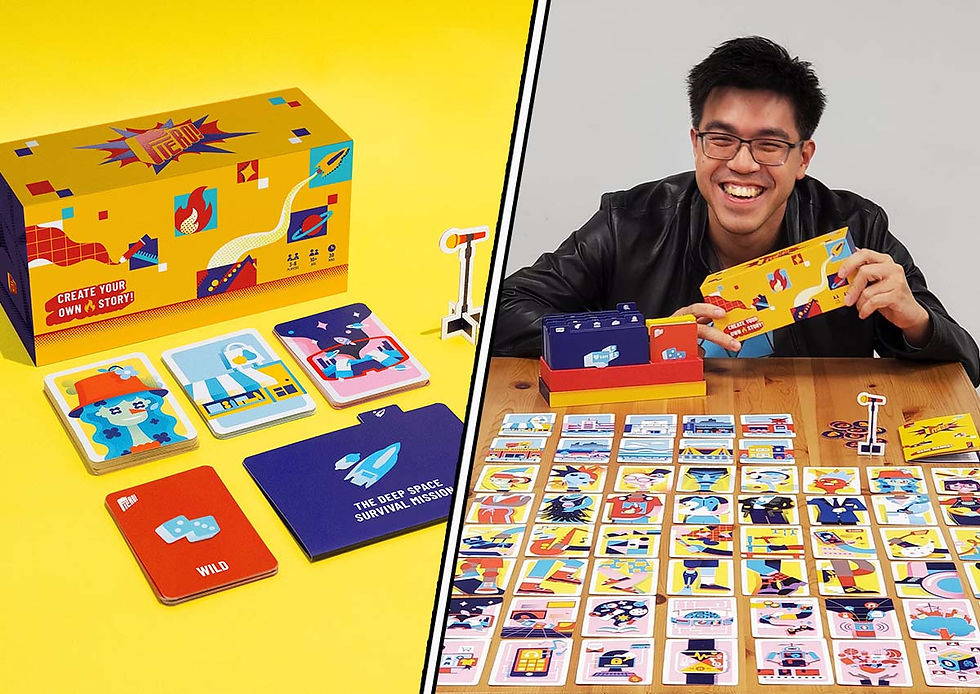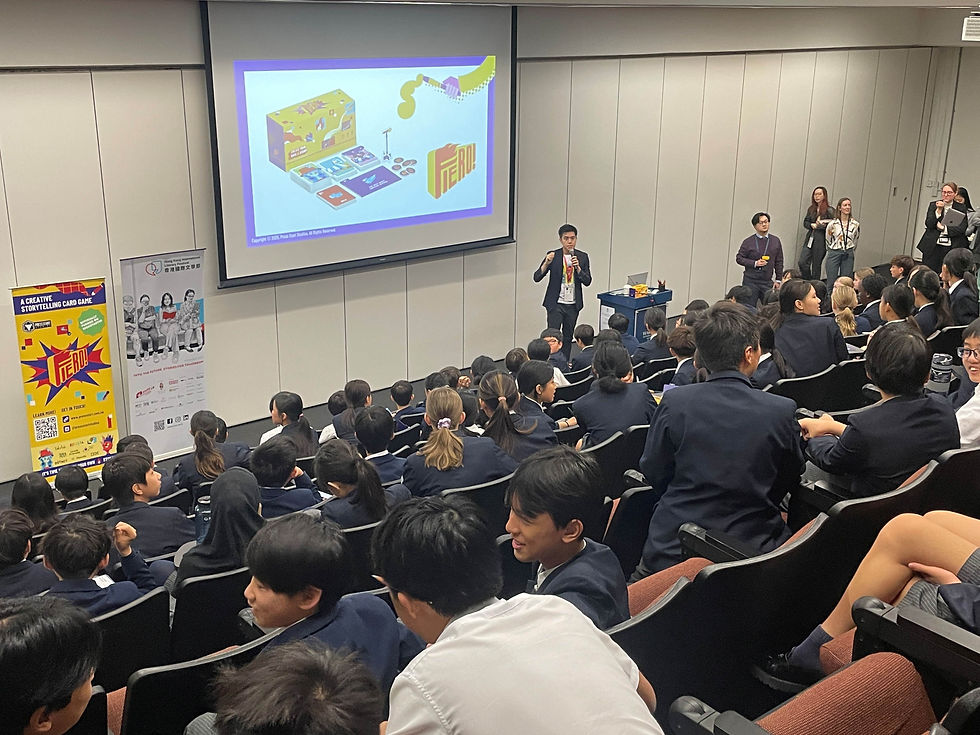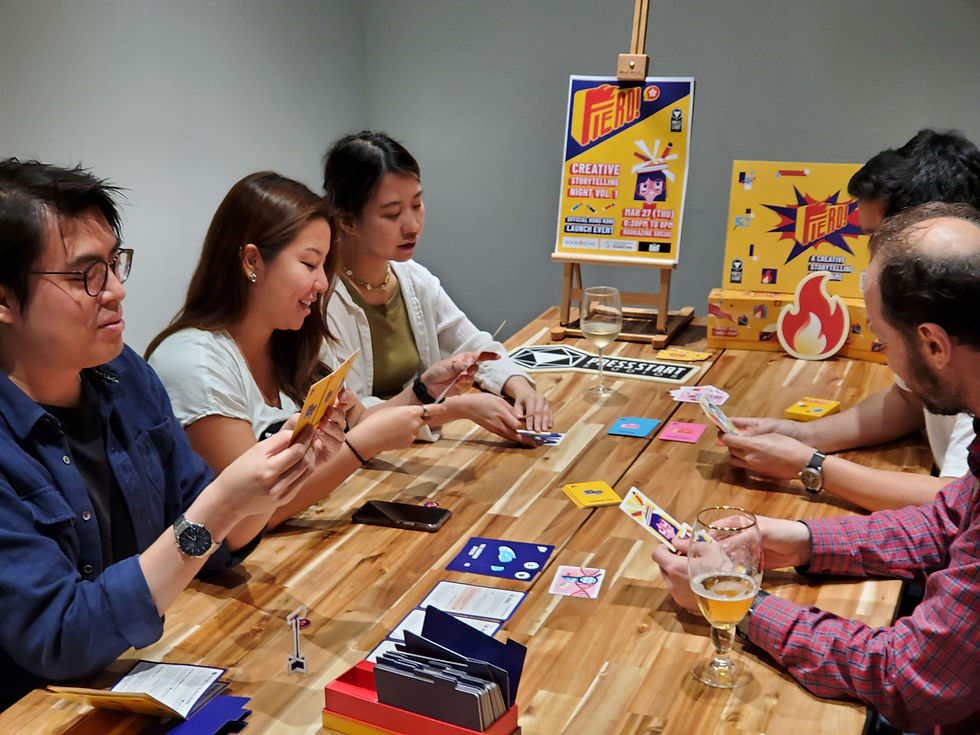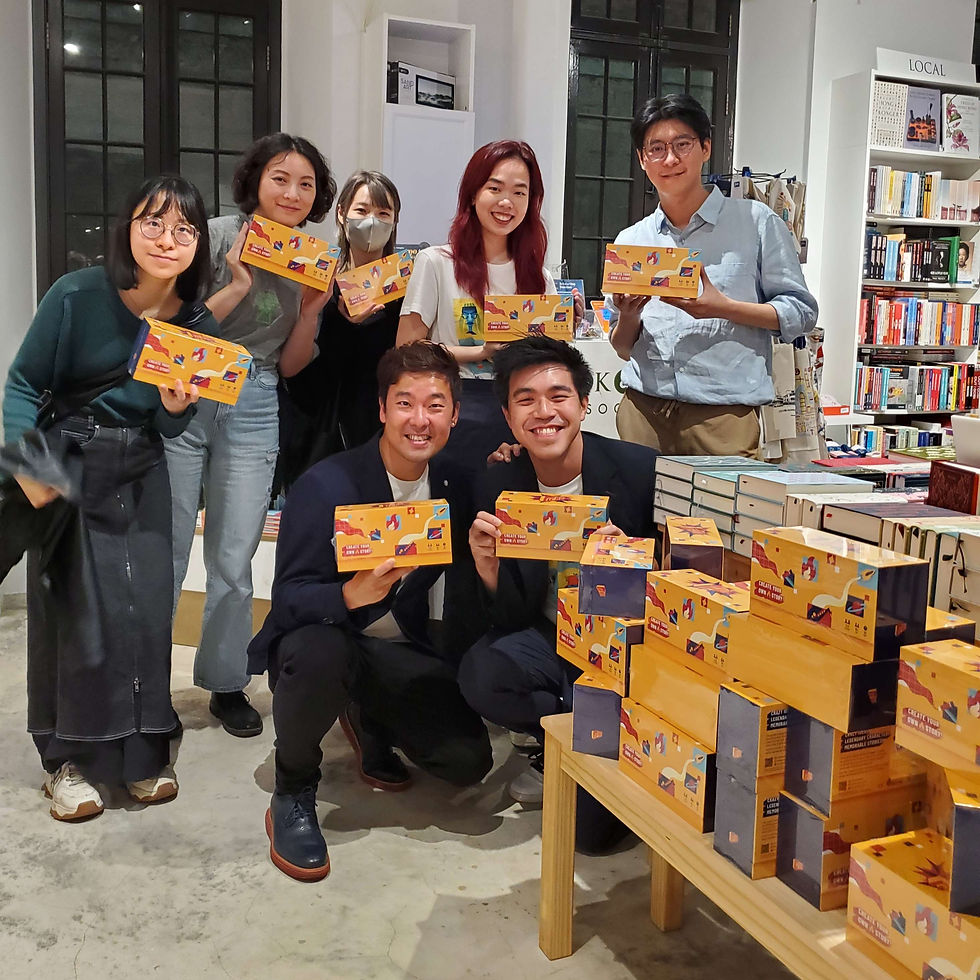From Classrooms to Card Tables: Vince Siu on Fiero! and the Power of Play
- Xeo Lye

- Aug 20
- 6 min read
Updated: Aug 21
What happens when teaching meets game design? Vince Siu talks about creating Fiero! and building a company around learning through play.

Q: Please give the readers a short introduction about yourself and your company and your product.
Hi, I'm Vince Siu, Founder and Lead Producer at Press Start Studios. We are a Hong Kong-based edutainment studio that designs game experiences for education and impact.
Press Start Studios is an extension of our main business Press Start Academy, an education company that creates and delivers game-based academic curriculum as after-school programs fostering creativity through writing, storytelling, and design. We believe that games are the most powerful way to learn.
We created Fiero!, a creative storytelling card game designed to spark imagination and collaboration. The game has three simple components: evocative visual Game Cards, exciting Story Briefs, and a fun, easy-to-use voting mechanic.
Players choose from 20 Story Briefs, inspired by popular culture genres like science fiction, cyberpunk, fantasy, romantic comedies, and reality TV, and step into the role of a creative team in a writers’ room. Guided by the five cards in each Story Brief, and drawing from Character, Location, and Opportunity decks in different combinations, players craft unique stories together from start to finish.
Q: What is your “origin” story, and how did you come about creating games?
I’ve been playing games since I was five, and I’ve been teaching since I was 16. I never pursued anything academically or professionally related to these two areas – I studied business and went into banking and consulting – but I suppose it was just a matter of time before I came full circle. I’ve never been professionally trained as a teacher, but that experience of standing in front of a classroom and trying to engage your audience came in handy professionally, and I was quickly asked to host townhalls and run workshops at work.
Press Start first started as a side project with a high school friend. We always loved playing games together, and after we moved back to Hong Kong, we started hosting Board Game Socials, which quickly evolved into planning and hosting game-based team-building events for friends and outside clients. Our first game design project landed on our figurative doorstep, despite not having any formal experience designing games, when a professor from a university reached out via a cold email asking if we could design a game for use in their classroom. Of course I said yes.

Q: Did your career inspire the creation of this game in any way? If so, how?
A couple of years into my journey with Press Start, I came across an interesting project called "Proto". A friend’s friend in Shanghai was running a small creative consultancy and was working on a small game about entrepreneurship and innovation, and he invited me to contribute to its development, given my professional experience in design thinking and corporate innovation, and my side project in games.
I had the opportunity to contribute to Proto, which became a storytelling card game, and in return he gave me the license to use it to run workshops on innovation and creativity in Hong Kong. That was the lease of life I’d wanted to quit my day job and dive into the world of games and creativity full-time.
My experience with Proto helped my young company secure a major project with the Hong Kong Design Centre, which commissioned us to design a game that teaches design thinking to a general audience. We created a game called "Divergence", named after the ideation step in the design thinking process, and its success in workshops and classrooms inspired me to develop a spiritual successor that would also become our first retail product.
Q: Why did your team decide to create this type of game?
Fiero! is my manifesto on creativity. Over the years, having worked with children and adults alike in different settings, I’ve come to realize that many people hold stigmas of creativity and are intimidated by having to be creative, often believing that creativity is something you’re born with. But I firmly believe that creativity is a muscle, not a gift: All we need to be creative is the right environment and right facilitation, so Fiero! sets about providing both.
Despite the amount of creative storytelling games out there, most provide either only visuals or only text and almost all require the players to create the context themselves under the guise of no-boundaries innovation. But the best ideas happen when there are constraints, and the best facilitators know how to set a structure and scope while leaving room for expression and experimentation.
My hope is that, even if you don’t believe you’re creative, after you spend 15-20 minutes on one round of gameplay with Fiero!, you can show yourself that you are.

Q: What was the design process like for Fiero? Did it differ from the traditional game design process? If yes, why?
Fiero! has been a long time coming, effectively the third iteration of the idea of a storytelling card game for creativity and innovation, so I’ve had the luxury of two previous projects to think about what I really wanted this game to be, as well as lots of data and feedback on what people enjoy and want an experience like this to be.
That being said, as this was to be our first ever retail product, I was also acutely aware of the difference in premise and approach between designing games as solutions and interventions for clients , and designing experiences that appeal to a target audience as inherently fun and easy to learn. Through multiple playtest sessions – many disguised as workshops and conference sessions – Fiero!’s development process spanned more than a year, reached more than 500 people, and went through multiple major iterations, before we settled on something I felt comfortable with.
Q: Fiero! was launched on Kickstarter and we notice that many of campaign rewards are non game related merchandises. With so much merchandise already planned to be produced, how do you plan to handle the extra inventory if sales don’t meet expectations?
This was the major risk I wanted to mitigate before starting this project, and honestly the main reason it took me so long to feel comfortable making the jump into retail.
That is why we chose to work with a renowned design agency in Hong Kong to handle branding, visual and graphic design, while also leveraging their extensive experience in physical production and manufacturing. We balanced a first-time Kickstarter campaign with a series of in-person community launch events, a format I was already comfortable with.
We also hedged the risk of slow retail sales by creating assets and curricula that allowed Fiero! to be applied in workshops and educational settings.
It was definitely more work than many designers might take on, but for me it was all about reducing the risk of falling short of expectations. I am not a marketer at heart, so if anyone reading this is interested in helping us build and execute a strong digital marketing plan to help us go viral, I would be glad to connect.

Q: If Fiero launches to mixed reviews, what would be your immediate next step?
There is no such thing as a perfect game. Even a masterpiece like Brass: Birmingham, my favorite board game, has its detractors. With that perspective, I am comfortable knowing that Fiero! may not achieve universal acclaim. What matters to me is that I was satisfied with the game before moving into production, a decision supported by extensive playtest data and the enthusiasm of our playtesters.
Of course, it is still important to take steps to mitigate risks as much as possible, which is why we developed the strategies and plans I mentioned earlier.
Q: What are some of the major challenges in designing a board game? What advice would you give board game designers?
There’s no such thing as patches, bug fixes, or easy DLCs when it comes to tabletop!
I’d say that having a strong vision – knowing what you want your game to achieve – is important, but equally important is being flexible in how to go about achieving it. It’s very possible for there to be different paths to achieving the same vision and goal, and that’s what your playtest sessions are for. Not all playtest feedback needs to be incorporated, but also don’t forget to check your ego at the door and be prepared for people to challenge everything and for yourself to have to go back to the drawing board. You’re not married to your ideas – only to your vision.
Q: Where can we find out more about your games?
We are always up to fun things around the world, so follow our adventures on Instagram @pressstartstudios. I hope to see you at an event, festival, or workshop soon. If you are interested in our commissioned work, collaborating on a project, or getting your own copy of Fiero!, visit our website at https://www.pressstart.com.hk
Vince will be showcasing Fiero! at Tablecon Quest 2025 at booth number : ID-10. Drop by their booth and try out their games if you are interested.








